Lectures 2009
January 30Climate Change and Earth's Endangered Bears
by Harry Reynolds
 The world's northern bear species are all endangered—affected by human influences and climate change. Alaskan Harry Reynolds has conducted extensive research on many North American large mammals (including polar bears, grizzly, and black bears) as well as studies throughout Asia and South America. Currently he is Team Leader for the Great Gobi Project—focused on the critically endangered Gobi bear. Reynolds' illustrated lecture will discuss worldwide bear endangerment with a focus on his recent work in Mongolia's Gobi Desert and the vanishing Gobi bear.
The world's northern bear species are all endangered—affected by human influences and climate change. Alaskan Harry Reynolds has conducted extensive research on many North American large mammals (including polar bears, grizzly, and black bears) as well as studies throughout Asia and South America. Currently he is Team Leader for the Great Gobi Project—focused on the critically endangered Gobi bear. Reynolds' illustrated lecture will discuss worldwide bear endangerment with a focus on his recent work in Mongolia's Gobi Desert and the vanishing Gobi bear.
Predicting the Future from the Past: The Legacy of Joe Grinnell
by Jim Patton
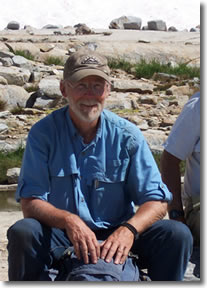 Curator and Professor Emeritus of UC Berkeley's Museum of Vertebrate Zoology retired from the classroom and walked right back into the field to continue his research and the important re-survey of Sierran birds and mammals. Since the pioneering work of Joseph Grinnell in the early 1900s nearly half of all bird and small mammals species have shifted their elevational ranges along the Yosemite transect.
Curator and Professor Emeritus of UC Berkeley's Museum of Vertebrate Zoology retired from the classroom and walked right back into the field to continue his research and the important re-survey of Sierran birds and mammals. Since the pioneering work of Joseph Grinnell in the early 1900s nearly half of all bird and small mammals species have shifted their elevational ranges along the Yosemite transect.
Landscape changes, fire suppression, and global climate change are implicated. Patton, who has traveled and studied in all continents excepting Antarctica, leads the field teams that repeat the original Grinnell surveys in Yosemite. He wonders where these animals will go when they've run out of room, crowded on the mountain tops.
March 27Charles Darwin and the Voyage of the Beagle
by Richard Hilton
In celebration of Charles Darwin's 200th birthday, the Sierra College Natural History Museum honors his important work with a special presentation. In this illustrated lecture, Richard Hilton will take the audience around the world as he examines the fascinating story of Darwin and the 1831-1836 voyage of the HMS Beagle. Darwin's journal of the voyage is a lively and exciting travel memoir as well as a detailed scientific field journal. The Voyage of the Beagle would foster ideas which Charles Darwin would later develop into his theory of evolution by natural selection.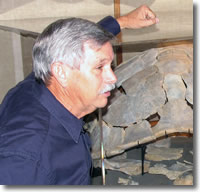
Richard Hilton has a life-long interest in Charles Darwin and has led numerous expeditions to the Galapagos Islands, South America, Africa, and has also traveled in Australia—all places that Darwin visited on the Beagle. Hilton is a professor of geology and paleontology at Sierra College. He has a Bachelors degree in Geology with a minor in Biology, and a Masters degree in Earth Science from California State University, Chico. Hilton is a paleontological consultant and an avid nature photographer. He is Chairman of the Sierra College Natural History Museum, and a board member of the California State University Chico, Geoscience Board, and the Northern California Natural History Museum. He has published numerous scientific articles in the field of vertebrate paleontology and a book entitled, Dinosaurs and other Mesozoic Reptiles of California (University of California Press, 2003.)
March 22Dinosaur Day & Science Fest
Fun for the whole family. 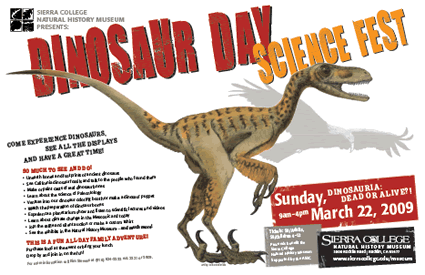
April 24
John Muir: Among the Animals
by Lee Stetson
 The icy storm story of a little dog named Stickeen is perhaps the most popular and most loved of John Muir's many adventures. This "funny, black, short-legged, bunchy-bodied, toy-dog", as he described Stickeen, gave Muir valuable insights into our kinship with all of the creatures humans share this good planet with—our "fellow mortals". Among other stories in this amazing collection of animal tales, Muir chases a Yosemite bear, confronts coiled rattlesnakes, mourns the loss of the passenger pigeon, and tells of his hilarious encounters with sheep in the Yosemite high country.
The icy storm story of a little dog named Stickeen is perhaps the most popular and most loved of John Muir's many adventures. This "funny, black, short-legged, bunchy-bodied, toy-dog", as he described Stickeen, gave Muir valuable insights into our kinship with all of the creatures humans share this good planet with—our "fellow mortals". Among other stories in this amazing collection of animal tales, Muir chases a Yosemite bear, confronts coiled rattlesnakes, mourns the loss of the passenger pigeon, and tells of his hilarious encounters with sheep in the Yosemite high country.
Under Our Skin
A film about Lyme Disease
A dramatic tale of microbes, medicine and money, this eye-opening film investigates the untold story of Lyme disease, an emerging epidemic larger than AIDS. Each year thousands go undiagnosed or misdiagnosed, told that their symptoms are "all in their head." Following the stories of patients and physicians as they battle for their lives and livelihoods, the film brings into focus a haunting picture of our health care system and its inability to cope with a silent terror under our skin.
Find out more at the film's website.
With us this evening will be Jordan Fisher Smith, author of the Booksense bestseller Nature Noir. Smith, who contracted Lyme disease from a tick bite near Auburn, is the narrator and a featured character in the award-winning film.
October 30Aspen Trees
by David Burton
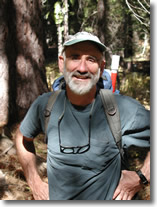 For many the symbol of autumn in the Sierra Nevada is the brilliant flash of color provided by the turning leaves of the Aspen trees of the range. Thousands trek into the Sierra to view the awe-inspiring, albeit brief, appearance of this natural display. But, the natural history and contemporary management of the quaking aspens is an even more intriguing story.
For many the symbol of autumn in the Sierra Nevada is the brilliant flash of color provided by the turning leaves of the Aspen trees of the range. Thousands trek into the Sierra to view the awe-inspiring, albeit brief, appearance of this natural display. But, the natural history and contemporary management of the quaking aspens is an even more intriguing story.
David Burton is principal coordinator of the Aspen Delineation Project, a collaborative effort of the Pacific Southwest Region (R5), California State Office-BLM, and California Department of Fish and Game. The Aspen Delineation Project was created in 2002 to assess the state of knowledge and management practice regarding aspen on public lands. The project focuses on how agencies have identified, mapped, treated, monitored, and studied aspen habitats. It also explores challenges, issues, and roadblocks surrounding aspen management. David is a full time Bureau of Land Management and United States Forest Service volunteer and recipient of the Forest Service’s National Individual Volunteer Award.
November 20The Fascinating World of the Ringtails
by Dave Wyatt
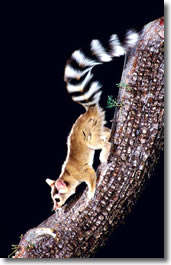 Biologist David Wyatt will present an illustrated lecture chronicling the life and habitat of Ringtails. The Ringtail (Bassariscus astutus) is a mammal of the raccoon family, native to arid regions of North America. It is also known as the Ringtail cat, Ring-tailed cat or Miner's cat. The Ringtail is found in California, Colorado, Oklahoma, Oregon, Arizona, New Mexico, Nevada, Texas, Utah, and throughout northern and central Mexico. For years, Wyatt has studied these animals on the Sutter Buttes, near Marysville. Over the course of twenty years of accessing the Buttes to study the Ringtail, his studies have revealed the Sierra Buttes Ringtail population density to be among the highest documented anywhere in the wild.
Biologist David Wyatt will present an illustrated lecture chronicling the life and habitat of Ringtails. The Ringtail (Bassariscus astutus) is a mammal of the raccoon family, native to arid regions of North America. It is also known as the Ringtail cat, Ring-tailed cat or Miner's cat. The Ringtail is found in California, Colorado, Oklahoma, Oregon, Arizona, New Mexico, Nevada, Texas, Utah, and throughout northern and central Mexico. For years, Wyatt has studied these animals on the Sutter Buttes, near Marysville. Over the course of twenty years of accessing the Buttes to study the Ringtail, his studies have revealed the Sierra Buttes Ringtail population density to be among the highest documented anywhere in the wild.
David Wyatt has taught biology and field ecology at Sacramento City College since 1998. He has studied bats in Belize, Mexico, and the United States. He has led numerous ecological tours in the Western Hemisphere and continues his 23-year Ringtail research in North America. Ringtail
Wyatt brings a wealth of experience to the classroom and lecture hall. Born in Hawaii in 1962, Wyatt settled in Sacramento as a child. As a student at American River College, he originally majored in criminal justice, but a class at ARC called “California Natural History” changed the course of his life and inspired him to pursue biology.
His influence extends far beyond the classroom. He also acts as the biological adviser for the Middle Mountain Foundation, a non-profit organization that educates the public about the Sutter Buttes, located in California’s Central Valley and known as the smallest mountain range in the world. Wyatt also served for ten years as a CalTrans biologist.
December 4Sierra Nevada Winter Ecology: Survival Strategies
by Ecologist Joe Medeiros
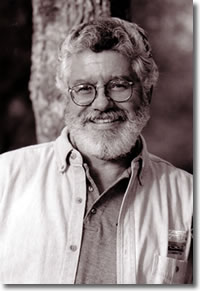 When winter arrives in temperate latitude habitats—myriad changes occur. Plants and animals alike make adjustments necessary to accommodate the cold and significant reductions in light energy. Migration, hibernation, dormancy and regeneration will be discussed, with a focus on our own Sierran species.
When winter arrives in temperate latitude habitats—myriad changes occur. Plants and animals alike make adjustments necessary to accommodate the cold and significant reductions in light energy. Migration, hibernation, dormancy and regeneration will be discussed, with a focus on our own Sierran species.
Joe Medeiros has hiked and studied in the Sierra for more than 35 years, lead countless trips of students and mountain enthusiasts, and served as a National Park Ranger at Devils Postpile National Monument in Mammoth Lakes, California.
Joe taught biological sciences at Sierra College from 1990 until his retirement in 2009. Joe is the co-coordinator of the college’s Sierra Nevada Lecture Series, and the major force behind the establishment of Sierra College’s People and Culture Days and the annual Earth Day celebration each Spring.
Joe also taught for many years at Modesto Community College and was the Founder and Director of that college’s outstanding Great Valley Museum. He was instrumental in the massive expansion of Henry Coe State Park in Morgan Hill, California, and in the establishment of Great Valley Grasslands State Park in Gustine, California.
Joe was honored as Sierra College Teacher of the Year in 1999, 2003, 2005 and 2007. In 2009, Joe received the prestigious “Placer Conservator Award” from the Placer Land Trust.
